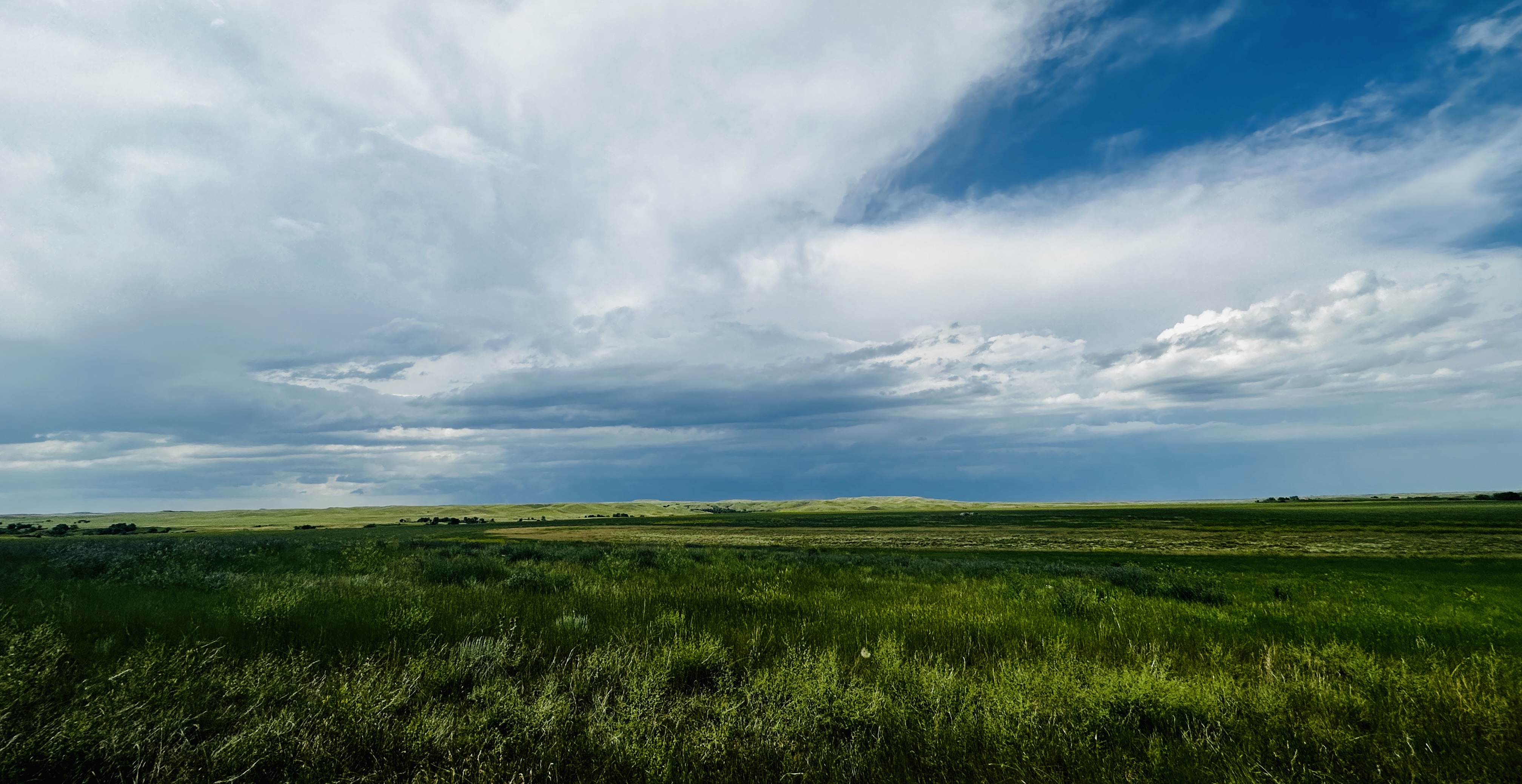
Dan O’Brien and his business partner Jill O’Brien (his former wife) live in one of the most beautiful places in America — in the Cheyenne River valley south and east of Rapid City, South Dakota. Their enterprise — the Wild Idea Buffalo Company — and Dan’s excellent books drew me there in mid-June. I’ve been reading his books for a long time, and from afar, I have been fascinated by their experiment in grass stewardship. I knew they host tours, but I was shy about visiting.
That was a mistake. They welcomed me into their world far beyond my merit. Jill had sent careful driving directions, so I didn’t get lost, but you do drive 20-some miles on gravel (this was fresh gravel) to get there. Dan’s house is in a draw, and as far as I could tell, the steep road down to his driveway is deliberately left a little adventurous, probably to make pilgrims earn the experience. I loved it.

We had dinner in Jill’s studio, perched on the western edge of the Cheyenne River valley. She’s a nationally acclaimed cook. The meal was exquisite, as was the rhubarb sauce on the ice cream as things wound down. Braised chuck roast, mashed potatoes, fresh asparagus, hot bread. Prosecco and very good wine. And the conversation was as good as the meal.
These are highly enlightened, well and deeply read, culturally omnivorous people, living in a magnificent place in the middle of nowhere and using their creative energies to regenerate the American grasslands, or at least their modest parcel of it. At dinner, we talked about Theodore Roosevelt, John Steinbeck, Henry David Thoreau, Jack Kerouac, Willa Cather, what happened at Wounded Knee, and William Hornaday (the man who saved the buffalo — with important help from others).

Dan O’Brien is the author of something just under 20 books. The one that brought him fame was Buffalo for the Broken Heart: Restoring Life to a Black Hills Ranch (2001). My next read will be his fictional account of the Pine Ridge Indian agent Valentine McGillycuddy, who is one of my fascinations. McGillycuddy was at Fort Robinson when Crazy Horse was killed. McGillycuddy offered to try to intervene during the Ghost Dance controversy. He argued that the U.S. government should just let the Lakota dance themselves out and that by sending in the military, the U.S. was making a potentially tragic mistake. He was right.
After supper, Dan, his partner Emily, and I drove around the ranch to smell the ozone awakened by a small but impressive thunderstorm that drifted over from the Black Hills during dinner. We rode in an open ranch ATV. It was just this side of chilly — in other words, perfect. The sky was washed and the grass hills were unusually green at the end of a wet spring. The quality of light was exquisite.
It’s not clear what the O’Briens’ neighbors think of them, but I know there is a relatively narrow range of eccentricities that most of America’s ranchers are willing to accept. In some quarters, the idea of running bison on prime cattle range is regarded as wrongheaded or even threatening, and complicated regeneration practices sound like hippy stuff.
The proof of O’Brien’s regenerative practices is in the … grass.
Dan picked me up from their guest cottage the next morning at 6:30 a.m. (I’m sure he thought I was a slacker.) We drove along slowly in his ATV through two or three gates, where I jumped down to open them and shut them after he drove through. It was a perfect morning. The grass was higher than the wheels of the ATV. He brought along an old-school thermos with coffee so black that it made you shudder on the first two sips. On our left, the Pine Ridge Indian Reservation, including the Stronghold, where the Lakota danced the Ghost Dance in the weeks before they were massacred by the remnants of the Seventh Cavalry on December 29, 1890. On our right, Black Elk Peak, the highest point between the Rocky Mountains and Europe. It was formerly named Harney Peak — named back when we celebrated the army officers who dispossessed Native Americans of land.

Over beyond a couple of swales and swells, we finally found the buffalo, some 800 of them, placidly eating grass, standing around, drifting a little now and then, the usual occasional rebuffed attempt by one sad male to mount cows. Dan shut off the ATV. The buffalo were entirely relaxed. A few of them nosed up within a couple of feet of the open cab. We saw a buffalo daycare facility a little ways away, with a few strong females watching over a dozen red calves. I had no idea. Dan had the confidence of a beekeeper amid swarms, and I took my confidence from him. Only once did the buffalo jump away when my 35mm camera “thucked” when I took a photograph. I apologized.
We sat there for most of an hour, sipping coffee, trading stories and perspectives, but I mostly just wanted to learn from this remarkable man. O’Brien doesn’t want to be romanticized. What they are doing in the Buffalo Gap region of South Dakota is hard work against considerable odds and some opposition for much less profit than the equivalent Angus ranch would produce. Because the buffalo are humanely raised and butchered — not merely trucked off like gold on the hoof to a commercial abattoir — the Cheyenne River Buffalo Ranch is more labor intensive than average. It’s hard work, and — compared to the dominant corn-petroleum-feedlot-industrial-complex — it’s a negligible part of the grasslands economy. But Dan and Jill believe what they are doing is a: intrinsically important, b: deeply soul satisfying, and c: a possible template for change on the Great Plains.
Regenerating the Great Plains

So, what do we mean by regenerative? Something like this. Most of the grass you see on the Great Plains was introduced from Eurasia well more than a century ago. Some of it came inadvertently, a stray seed in the bottom of a bag of flour. Still, some was deliberately introduced by well-meaning busybodies, thus reinforcing — once again — the “law of unintended consequences.” The invasive species choked out native grasses. They don’t provide more nutrition per square foot than native grasses. They are biological bullies. Restoring the native grass is exceedingly expensive (where is the Farm Program when you need it?), time-consuming (years, maybe decades), and the seeds one needs are relatively hard to get at any price anyone but Ted Turner could afford.
Meanwhile, the grasses of the Great Plains have been severely over-grazed until very recently (and still in some pockets). Thus the soil health is not great. It may seem insane for white settlers to have replaced native grasses that have evolved on the plains over millions of years, which supported what the writer Dan Flores calls the “American Serengeti” — buffalo, prairie dogs, coyotes, wolves, pronghorn antelope, elk, two varieties of deer, grizzly bears, falcons, hawks, and eagles, and widely dispersed human communities that had found a way to thrive in this place sustainably. We displaced most of those beings, including Native Americans, plowed up as much land as possible, and then watched an estimated 1.2 billion tons of soil blow away forever during the Dust Bowl years. During a Congressional hearing in Washington, D.C., in March 1935, elected representatives walked outside to view a dust storm that had traveled all the way from the Great Plains. The New Deal helped to stop the carnage: Soil Conservation Districts, Shelter Belts, the Civilian Conservation Corps, County Extension Agents.
Even so, nobody can argue that the grass of the Great Plains today is as healthy as it was in 1805 when Lewis and Clark wandered through. Dan and Jill O’Brien are not alone in their quest to restore the flora and fauna of the Great Plains, but they have won great respect, including international respect, for their exemplary practices.
They raise buffalo for the market. They supervise the butchering of every critter in a mobile truck that is fitted out not to replicate the factory conditions of America’s huge slaughterhouses. The O’Briens sell the meat (order at wildideabuffalo.com). The buffalo hides go to Portugal where they are made into high-quality boots. They sell some of the buffalo skulls; most are repurposed in an environmentally responsible way. They host tours. And Dan gets some royalty checks for his books. But it’s mostly about psychic income. As Jill said over dinner, “Everyone here has a side gig.”

Here’s the part of what they are doing that blew my mind if I may use a technical term. Dan said the buffalo help restore the native grasses. Just how is a little unclear to me. He said the native seeds are still in the ground after all this time and all they need are the right conditions to recover. And when this is done right — via buffalo grazing, not pesticides — the grasslands begin to regenerate. Properly managed, the native grasses start to overcome the invasive species. It sounds mystical, but I’m sure there are reliable evolutionary explanations. A cow is not a buffalo. A buffalo is not a cow. They eat the same stuff, but they work the land differently. Perhaps it is not beyond the realm of possibility that the buffalo know what they want to eat and have the ingenuity to make sure it can grow again! The Lakota, Cheyenne, Mandan, Hidatsa, Crow, and Blackfeet regarded the buffalo as sacred. Who are we, who regard cattle as commodity and grass as fodder, to think we know better?
I wasn’t at the ranch very long — not long enough. But I know how to get there now, and Dan and Jill invited me back to observe and perhaps help out when they are butchering.
And there is more. Among other things, Dan O’Brien is a falconer. That instantly gets my attention. The art of falconry dates back to at least 2000 BCE in Mesopotamia and probably much longer. You can find references to it in one of the oldest pieces of world literature, the Epic of Gilgamesh (ca. 1500 BCE). Homer’s Odysseus is said to have brought the art of falconry back to Ithaka and Greece at the end of the Trojan War. Falconry was the avocation of Elizabethan aristocrats (and today’s Saudi princes). We had a long discussion about falconry in Shakespeare. One of my heroes, Sir Richard Francis Burton (1821-1890), published a masterful book called Falconry in the Valley of the Indus in 1852. I’ve observed the superb falconry program at the U.S. Air Force Academy, thanks to my old friend Hal Bidlock (aka Alexander Hamilton, I’m sorry to say). I want to see Dan work the birds.

My goal in Listening to America is to get out from under the echo sphere of cable media and the surface discourse of polarization and rage and search for America where it percolates. I believe millions of people are doing good and creative things all over what Steinbeck called “this monster land,” tens of thousands or hundreds of thousands of people engaged in cutting-edge and game-changing initiatives like the O’Briens. I want to cheer up about America. I want to remind myself — and you — that major media is a dangerous distortion mechanism that exaggerates the ways we disagree and ignores the geographic, political, economic, and cultural “commons.”
In other words, America is better, healthier, and less divided than it seems when your lens is FOX or MSNBC.
Learn more about the Cheyenne River Buffalo Ranch and Wild Ideas “beef.”
Book a tour and buy Wild Ideas products.
You can find a complete list of books by Dan O’Brien in the usual places. I recommend:
- Buffalo for the Broken Heart: Restoring Life to a Black Hills Ranch
- Wild Idea: Buffalo and Family in a Difficult Land
- The Contract Surgeon: A Novel (about Valentine McGillycuddy, see above)
- Great Plains Bison
- Equinox: Life, Love, and Birds of Prey
- In the Center of the Nation: A Novel

